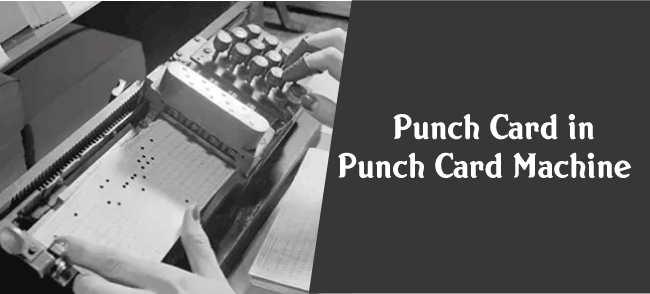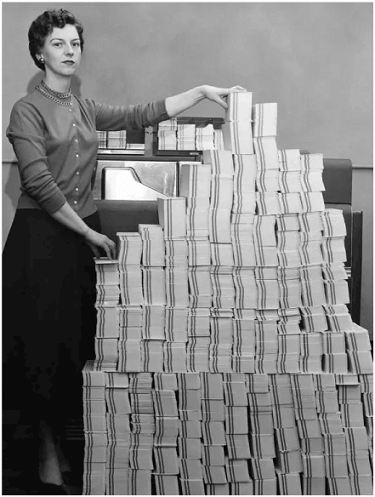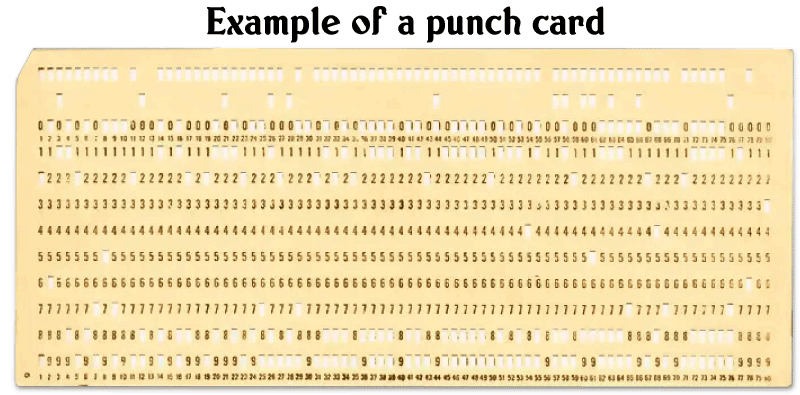What is Punch Card System??Punch cards are usually spelled "punched cards". These are paper cards with holes that can be made manually or mechanically to represent computer data and instructions. They are also referred to as Hollerith cards and IBM cards. Entering data into early computers, they were a commonly utilized method. The cards were placed into a card reader that was attached to a computer, and the computer translated the holes' order into digital data. For instance, a handwritten program might be converted into numerous punched cards using a punch card machine by a computer programmer in the early days. Following that, the programmer would bring the stack of cards to a computer and input the program using a card reader. 
How were punch cards operated?Punching holes in each column (one for each character) using a punch card machine allows data to be entered into the card. The card technically "stores" the information after it is finished or the Return key is hit. If you use punch cards to develop a program (one card for each line of code), it takes a stack of cards because each card can only carry so much data. To use a punch card reader, each card must be inserted, read the data from the card, and entered into the computer to read data from a punch card or load the software. The punch card reader begins reading the card as it is inserted, moving vertically from top to bottom, beginning at the top-left corner of the card. The card reader reads the following column after it has finished reading the previous one. It would be written to a computer's memory as the reader read the information. The computer would then be told to run the code when all cards had been loaded into memory. Punch cards would be used as output if the information were to be printed. The1950s SAGE air defense systemwas the largest punch card program (around 5 MB of data)which employed 62,500 punched cards. Dropping punch cards was one of the main concerns of consumers when using them. The program might take days or weeks to bring back into order if these cards were dropped or became out of order.It might not be feasible to restart the software in some circumstances. How is a punch card read by a person?With the majority of subsequent punch cards, the contents of each card were printed at the top of the card. With these cards, the information recorded on the card may be seen by looking at the top of the card, and it would be reprinted if a mistake was found on the card. The human would have to know what each number stood for and manually translate each column if there was no data printed at the top of the card. If you are conversant in contemporary computers, it is comparable to knowing that the binary values 104 and 105, which are combined to form the ASCII character "hi", correspond to the numbers 01101000 and 01101001, respectively. The history of punch cards.Punch cards are reported to have been used to operate textile looms as early as 1725. For instance, Joseph Marie Jacquard utilized punch cards to weave a silk self-portrait in the 1800s. Semen Korsakov used the cards in 1832 to store and find information. Herman Hollerith created a mechanism for machines to capture and store data on punch cards later in 1890 so that it could be utilized for the US census. Later on, he founded the business that is now known as IBM. 
Why did punch cards get used?The ability to save files was not present in early computers. The only way to use data with other computers was to use a punch card to construct a data file or program. Punch cards were no longer utilized after the development of magnetic media, which became more affordable. Are Punch cards still in use?In the early 1900s, punch cards were the main tool for storing and retrieving data. Punch cards were first replaced by other storage technologies in the 1960s, and today they are seldom ever used or seen. Punched cards can be used as input.No, the punched cards are not input devices themselves. On the other hand, the punch card reader is regarded as an input device because it transfers data from the punch card to the computer. How were punch cards programmed, and why were punch cards chosen?Punch cards and other pre-existing technology were utilized, such as paper tape. It originated with early methods of vote counting in 1890. The IBM 401 from 1933 was a design that was highly reminiscent of those used in subsequent computers. The punch card reader was the IBM407, and it was first used in the middle of the 1960s. Similar to paper tape, it was employed because it was a readily adaptable existing technology. Regarding the language, I used FORTRAN IID, with the D standing for the computer's new-fangled disc storage system. However, the bootstrap code for the IBM1130 was also stored on punched cards and was loaded directly into memory. What did punch card coding feel like?The coding was much more effective than it is now. In an experiment FORTRAN course is taken in the final years of punched cards. For each program, it had three attempts to get it properly. Like hitting the RUN button only thrice, we were astonished that it could complete most of the 25 programs in just two attempts before using the third run to either try something new or improve the output formatting. On the coding sheet, carefully code the program's initial try. Get the printout from the first run; compilation mistakes will be clear. Do not instantly debug it; instead, take it home and manually run it using the printout. Then on the printout, note each error and make the necessary corrections. Pick each incorrect card one at a time, up until the column where it belongs. After that, make the necessary corrections, which are on the card. Next time, bring it back to the computer center. In experiment used a machine for rectificationthat we had to operate ourselves. After placing the two cards as directed, click the copy button to move both to the proper column. When the automatic machine was overloaded, we occasionally had to physically punch on a manual Hollerith code machine by twisting our fingers. The machine resembled this, except to make matters more difficult, it only displayed numbers as opposed to the letters shown in this image. 
Has a C compiler been created that outputs to punch cards?You may use any existing compiler for any language to feed data into a punched card reader, and then read the cards back into a compatible computer and run the program. Punched cards are a data storage system. The same logic applies to determining whether memory sticks or hard drives require a different compiler than punched cards. The type of data storage is unimportant. How did punch cards store non-digital computer data?Like magnetic tape or magnetic discs, punch cards are digital. The bits are represented by holes that are strategically positioned on a light paper card. The card allows light to pass through that either doesn't shine through where there is a hole or doesn't shine through where there is a hole. It is digital data. Discs work with magnetic fields that can reverse or not, depending on the type of media. Both of these examples use digital data, yet the actual items in the real world are analogue. All of reality contains analogue phenomena. Punch cards are merely another sort of digital data storage in this regard. What did the remaining six bits per column on punch cards perform (history, IBM, mainframe, punched cards, retrocomputing)?An excellent joke first. How was Herman Hollerith interred after his passing? 9-edge right, inverted the punch card for an electronic tabulating machine was initially created by Hollerith(for a detailed history, search "Hollerith" on Google). It's why it is (to some of us) so amusing. You would place the stack of cards with the 9-edge facing down and either to the right (or left) of the card reader (or up). The explanation Thomas provided for the "holes" was excellent. You would use the entire 80-column card if you were representing data. You had to adhere to the Cobol constructs (code in columns 8-72; column 6 for the comment character and column 72 for continuation if necessary) if you were using it for Cobol code. Initially used an IBM 026 punching machine. In those days, there was no hanging chad, so you could remove the chad and deface someone's room. Sequencing was performed on Col 73-80. The more recent card punch devices would automatically sequence your cards for you. So you could run your cards through a card sorter if you dropped your deck or if a stupid operator shuffled your cards. I can assure you that you don't want to manually sort a program with 1000 cards, according to Cobol constructions cols.
Next TopicWhat is RDIMM
|
 For Videos Join Our Youtube Channel: Join Now
For Videos Join Our Youtube Channel: Join Now
Feedback
- Send your Feedback to [email protected]
Help Others, Please Share









